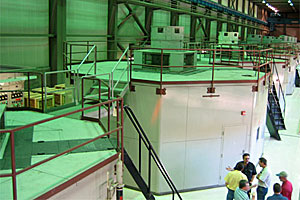 Harvey O. Banks Pumping PlantI'm standing in the Harvey O. Banks Pumping Plant, part of the State Water Project (SWP), looking at a set of huge pumps that slurp water from the Delta and hoist it 244 feet to the mouth of the California Aqueduct. The sensation is a little akin to the how I felt when, not long after college, I rode a sailboat through the Panama Canal: a kind of jaw-dropping wonder (dismay?) at the scale of this engineering feat. When we humans set our minds to re-arranging the landscape, we don't kid around.
Harvey O. Banks Pumping PlantI'm standing in the Harvey O. Banks Pumping Plant, part of the State Water Project (SWP), looking at a set of huge pumps that slurp water from the Delta and hoist it 244 feet to the mouth of the California Aqueduct. The sensation is a little akin to the how I felt when, not long after college, I rode a sailboat through the Panama Canal: a kind of jaw-dropping wonder (dismay?) at the scale of this engineering feat. When we humans set our minds to re-arranging the landscape, we don't kid around.
In my last post I wrote about visiting a treatment plant to see where our water goes after we've washed the dishes. Now, on this tour of the Banks plant, I'm getting a glimpse "upstream" of the kitchen tap and learning more about where our water comes from.
The scale of the SWP is mind-boggling: More than two in three Californians rely on it for at least part of their drinking water. It is the largest publicly built and operated water project in the country, encompassing 17 pumping plants, more than 30 storage facilities, and over 660 miles of canals and pipelines. At the south end of the San Joaquin Valley at the Tehachapi Mountains, the huge Edmonston Pumping Plant raises the water 1,926 feet-the highest single lift in the world. (If you're driving to Southern California, check it out on the right side of I-5 just before the Grapevine). Moving all that water around and hoisting it over mountains doesn't come easy (water is heavy, after all): The SWP is the largest single user of electricity in the state.
The Banks plant is named for Harvey O. Banks, Director of Water Resources when voters approved funding for the SWP in 1960. The project was ostensibly conceived as a solution to the problem that most of California's water is north of the Delta, while most of its people are to the south and west. Big agricultural interests in the southern San Joaquin Valley also benefited-hugely-from "surplus" water shipped south. (And lest we Northern Californians start feeling smug, keep in mind we receive a greater percentage of our total water supply from the Delta than does Southern California.)
The Banks plant draws water from the Delta through intake gates into Clifton Court Forebay. From there, the water is pulled up a channel to the Skinner Fish Facility, where delta smelt, Chinook salmon, and some 90 other species of fish are, theoretically, screened out so they won't get sucked into the pumps (More on fish screening in my next post). But getting squashed in the pumps is not a fish's only worry: The pumping actually alters the habitat by impacting salinity and flow, disrupting natural rhythms that serve as vital cues for migration and spawning. The old joke that in California water flows uphill toward power and money is not far off the mark: The pull of the pumps is so powerful it causes rivers to flow backwards-literally uphill.
